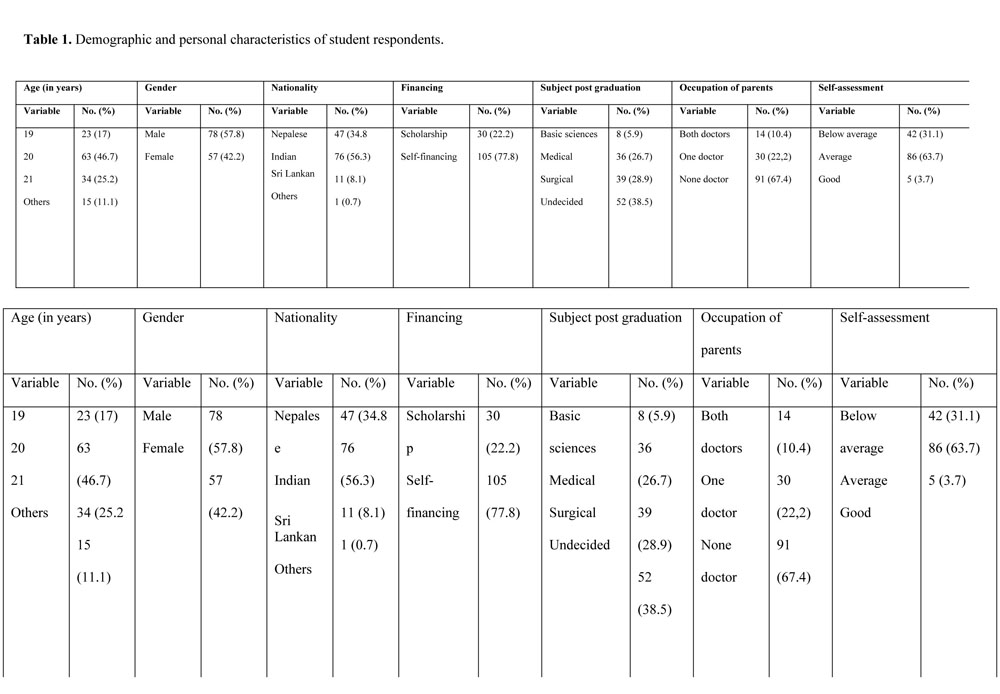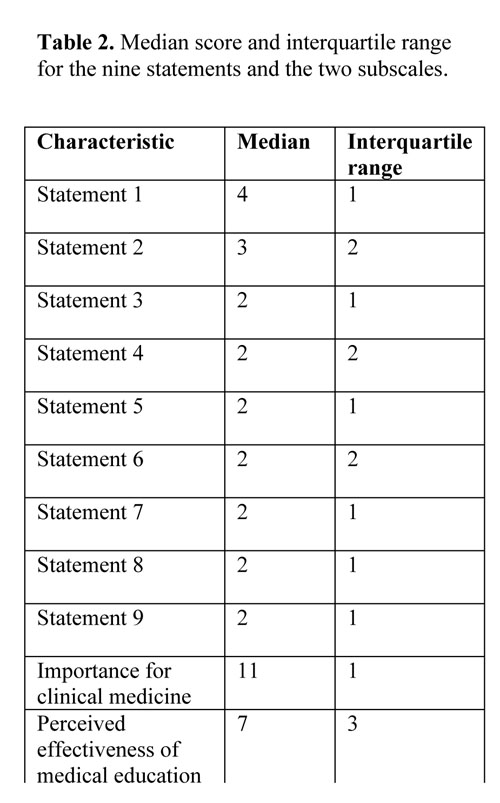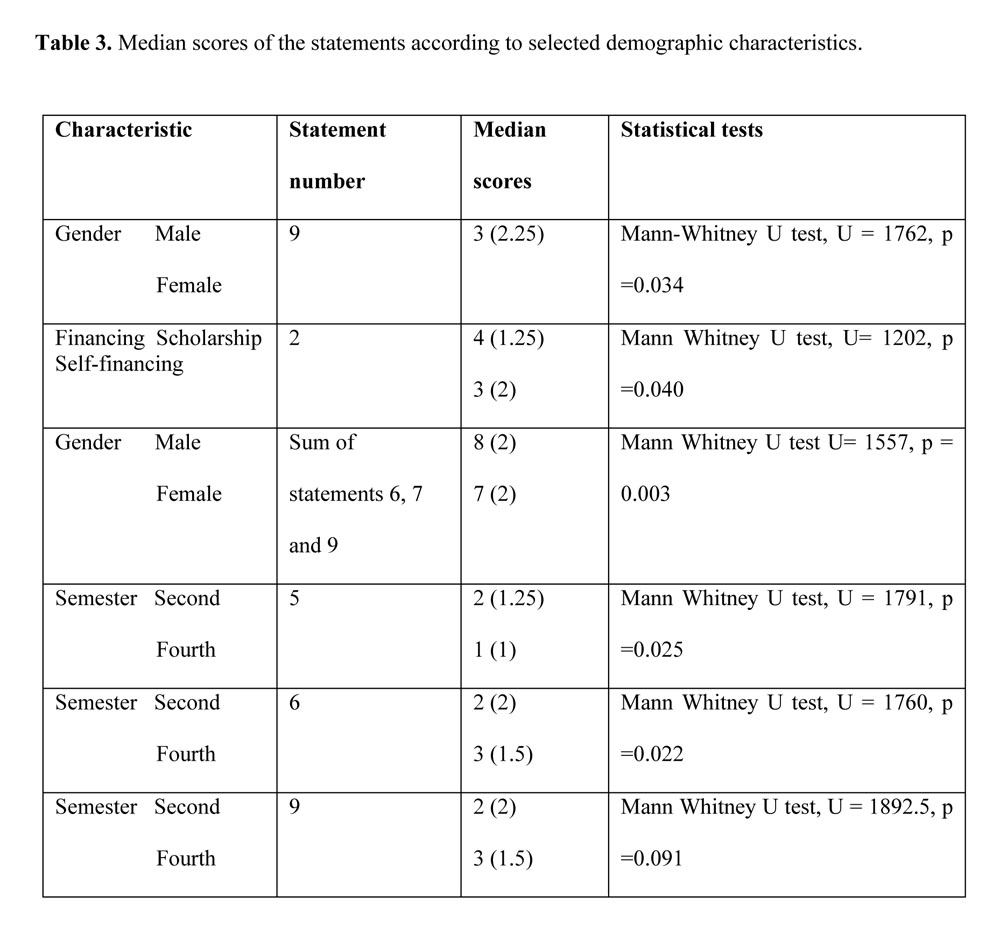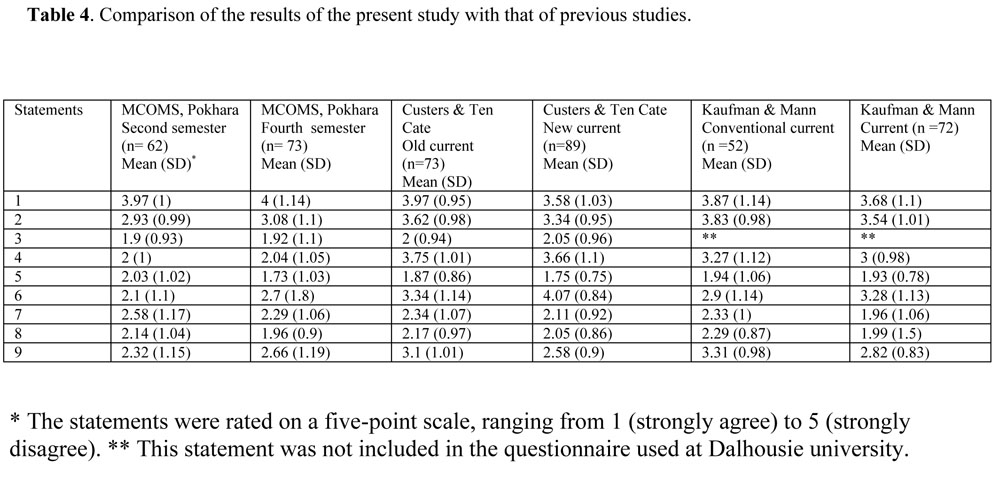ABSTRACT
The basic sciences in Nepal are taught during the first four semesters of the undergraduate medical course. The objectives of this study were to obtain information on the attitudes towards and perception of the basic sciences among second and fourth semester students and note the association, if any, of the attitude with the respondent personal characteristics. The study was carried out among second and fourth semester medical students at the Manipal College of Medical Sciences, Pokhara, Nepal during March 2005. The student attitudes towards the basic sciences were assessed by noting their degree of agreement with a set of nine statements using a modified Likert-type scale. The median scores for the different statements were compared among the various subgroups of respondents. Sixty-two of the 75 second semester (82.7%) and 73 of the 75 fourth semester (97.3%) students successfully completed the questionnaire. Female students were more in agreement with the statement ‘Faculty members excite students’ curiosity through the teaching of the basic sciences’ compared to male students (p=0.034). The female students had a more positive opinion regarding the ‘perceived effectiveness of medical education’ compared to males (p=0.003). Significant differences in the median scores of some statements were seen between the second and fourth semester students. Greater emphasis should be placed on the psychological aspects of medical treatment and on teaching about applying basic sciences to clinical medicine. Similar studies in other medical schools would add to this data. The students overall had a positive opinion towards the basic sciences.
INTRODUCTION
At the Manipal College of Medical Sciences (MCOMS), Pokhara, Nepal the basic science subjects (Anatomy, Physiology, Biochemistry, Pharmacology, Pathology and Microbiology) are taught during the first four semesters of the undergraduate medical (MBBS) course. Teaching and learning of Community Medicine starts from the first semester and continues until the seventh semester. The curriculum of Kathmandu University with which the college is affiliated was revised in 2001. The revised curriculum now emphasizes integrated, organ-system based teaching of basic medical science subjects. These subjects are linked with Community Medicine and frequent hospital visits are emphasized to give a clinical orientation to the subjects.1 The students are introduced to clinical knowledge and skills utilizing a problem solving approach.
Traditional basic science teaching has been as individual disciplines unrelated to other basic science disciplines and the student future medical practice.2 Though an integrated approach to teaching is followed in our institution, assessment is still done subject wise. Subjects are taught to prepare students for assessments and unfortunately the process of integrating with other basic science and clinical subjects is not always emphasized. It has been observed that basic science knowledge learned in a clinical context is better comprehended and more easily applied by the students.3,4
At MCOMS, we use a combination of didactic lectures, problem-stimulated learning (PSL) sessions, student seminars and community-based learning (CBL) for teaching the basic sciences. During the clinical orientation module, history taking and physical examination, both general and system wise are covered.
To measure student attitude towards and perception of the basic sciences, an instrument was developed by West, Mennin, Kaufman, and Galey.5 The same instrument was used by other authors in later studies2,6 and has also now been applied to our students. Information on student attitudes towards basic sciences are so far lacking in colleges in Nepal and would also provide additional data for medical schools in other countries. Hence the present study was carried out. The objectives of the study were to:
a) obtain information on the attitudes towards and perception of the basic sciences among second and fourth semester medical students and
b) note the association, if any, of the attitude with personal and demographic characteristics of respondents.
MATERIALS AND METHODS
Participants: The study was carried out among second and fourth semester medical students at the Manipal College of Medical Sciences, Pokhara, Nepal during March 2005. The second and fourth semester class consists of 75 students each and all students were invited to participate. The objectives and the scope of the study were explained and the students were assured that individual demographic and personal information collected would be kept confidential. Verbal consent was taken. However, written informed consent was not obtained. Sixty-two second semester and 73 fourth semester students participated in this study.
Instrument: The demographic and personal characteristics including age, sex, nationality and occupation of parents were noted. Information was collected on the method of financing of medical education and the preferred specialty for post graduation. The respondents were asked whether they would consider basic sciences as a career option. Information on whether the respondents were graduates of a graduate study program and the place of residence was noted. The students were asked to rate themselves academically as excellent, good, average and poor.
The questions designed by West and coworkers5 were presented in English. The questionnaire used is shown in the Appendix. The students were asked to denote their degree of agreement with the individual statements using a 5-point Likert type scale. Items 1, 2 4 and 5 assess the perceived importance and relevance of basic sciences for clinical medicine while items 6, 7 and 9 assess the perceived effectiveness of medical education. The forms were distributed to the students during the pharmacology practical sessions. The objectives of the study were explained to the students and they were invited to participate. The completed forms were collected at the end of the session.
Analysis: The median scores for the different statements were compared among different subgroups of respondents. The median scores of individual statements and of the two subgroups of statements were compared. The students were divided into subgroups according to nationality, method of financing of medical education, preferred specialty for post graduation, occupation of parents and place of residence. The median scores of the statements and the two subgroups were compared among the second and fourth semester students. For the purpose of analysis, the occupation of parents was grouped into three: students with both parents’ doctors, students having one doctor parent and students without doctor parents. The subjects for post graduation were grouped into basic sciences, medical specialties and surgical specialties. The Mann-Whitney U test was used for dichotomous variables and the Kruskal Wallis test for the others. A p value RESULTS
Sixty-two of the 75 second semester (82.7%) and 73 of the 75 fourth semester students (97.3%) successfully completed the questionnaire. The demographic characteristics of the responders and non-responders are comparable. The majority of the respondents (88.9%) were 19, 20 and 21 years of age. Seventy-eight respondents (57.8%) were male. Forty-seven respondents (34.8%) were Nepalese while 76 (56.3%) were from India. The demographic and personal characteristics of the respondents are shown in Table 1. The majority of students [105 students (77.8%)] were self-financed and from urban areas [118 students (87.4%)]. The majority of students rated themselves as good or average (not shown). Basic sciences were not preferred subjects for post graduation. However, 35 of the 70 self-financing students (50%) responded that they may consider the basic sciences as a career option.
Only 4 students (3%) had joined the undergraduate medical course after first completing a graduate course of study. A majority of students [91 students (67.4%)] did not have doctor parents and rated themselves as average students [86 students (63.7%)]. The characteristics are shown in Table 1. The median score for the two negative statements about basic sciences (statements 1 and 2 in the Appendix) were showing high disagreement with the statements. The median scores for the other statements (statements 3, 4, 5, 6, 7, 8 and 9) which were positive about basic sciences were showing low agreement with the statements. The students had a favorable opinion regarding the basic science subjects.
The median score and the interquartile range for the nine statements and the two subgroups of statements are shown in Table 2. Table 3 shows the median scores of the statements according to selected demographic characteristics of the respondents. Female students were more in agreement with the statement “Faculty members excite students’ curiosity through the teaching of the basic sciences” (statement number 9) compared to male students (p=0.034). The scholarship students more strongly disagreed with statement 2 (basic science research being far removed from clinical medicine) compared to the self-financing students. The female students had a more positive opinion regarding the “perceived effectiveness of medical education” (sum of the scores of the statements 6, 7 and 9) compared to males (p=0.003).
The median scores of the individual statements and of the two subscales were compared among the second and fourth semester students. The significant differences have been shown in Table 3. The fourth semester students agreed more with statement 5 that applying basic sciences to clinical
medicine is a skill which should be learned early on in medical education (p= 0.025). The second semester students agreed more with statement 6 regarding acquisition of facts in basic sciences compared to the fourth semester (p=0.022). The second semester students agreed more with the statement number 9 that faculty members excite student curiosity through the teaching of basic sciences compared to the fourth semester (p=0.091).


Table 4 shows the mean ± SD scores of the nine statements in our study compared to those of the study by Kaufman and Mann and Custers and Ten Cate. Some of the scores reported in our study were lower and others higher than those reported in previous studies. Lower scores denote a greater degree of agreement with the statements. Our scores for the statement 1 “A physician can effectively treat most medical problems without knowing the details of the biological processes involved” was slightly higher compared to that reported previously. The scores for the statement number 2 (basic science research being far removed from clinical medicine) were lower. Our students showed a far greater degree of agreement with statement 4 that knowledge of biological mechanisms is the most important facet of a good physician. They also tended to agree more with statement 9 “Faculty members excite students’ curiosity through teaching basic sciences” compared to previous studies.
DISCUSSION
Rangachari has written that “The basic medical sciences play elegantly the role of villains, subjecting students to volumes of increasingly arcane information”.8 It has been observed that each discipline is convinced that “it represents the most important part of medicine and turns on the spigot of information” forcing students to question the relevance or irrelevance of the information.8
MCOMS admits students from Nepal, India and Sri Lanka for the MBBS course. A few students come from other countries. The Nepalese scholarship students are selected through an entrance examination conducted by the Ministry of Education (MoE). The Nepalese self-financing students are selected on the basis of an entrance examination conducted by Kathmandu University (KU) with which the college is affiliated. The students from India and Sri Lanka are selected on the basis of their twelfth standard marks.
Like in previous studies2,6 the sex ratio of the respondents in our study was not equal (M/F=78/75). In our study the female students were more in agreement with statement 9 (Table 3). There is a hypothesis that males may be more technically oriented than females and may value the basic sciences more. In a previous study, females agreed more with the statement that psychological factors are just as important in the healing process as physical factors.2 The female respondents had a more positive opinion of the effectiveness of medical education.
We compared our study with those conducted by Custers & Ten Cate at Utrecht2 and by Kaufman & Mann at Dalhousie6 which had used a similar questionnaire. These studies had compared student attitudes towards basic sciences under an innovative integrated curriculum. Differences in the curriculum, teaching methods and cultural differences may be confounding variables in the comparison. However, our results are quite similar to those reported by other studies (Table 4), with statement number 4 providing the highest variance.
The scholarship students disagreed more with statement 2 (Table 3). A greater proportion of self-financing students (50% of the total) answered that they may consider the basic sciences as a career option.
There were no significant differences in the statements according to other demographic characteristics. We have only shown the statements where there were significant differences between the subgroups of respondents. Our students had a better opinion regarding the ‘perceived importance and relevance of the basic sciences for clinical medicine’ (sum of statements 1, 2, 4 and 5) and ‘perceived effectiveness of medical education’ (sum of statements 6, 7 and 9) compared to that reported previously.2,6 However, our study was conducted among only the basic science subjects compared to the previous studies which were done among students doing their clerkship.

There was a positive change towards statement 5 as we moved from the second to the fourth semester (Table 3). This is a welcome sign. However, the second semester was more positive regarding the role of the faculty members in exciting student curiosity through the teaching of basic sciences.
Our students were of the opinion that detailed knowledge of the biological processes involved is necessary to effectively treat patients compared to the results from the previous studies (statement number 1). They also agreed to a greater extent with the statement 9. These are welcome signs for a basic science educator. However, the students also agreed to a greater extent with statement 2 regarding the low usefulness of basic sciences for the practicing doctor. This is a dissenting statement in the overall positive opinion regarding basic sciences and the reasons have to be investigated further. Despite the limitations of the comparison previously mentioned, the comparison with two previous studies2,6 gave us an idea regarding the perception and attitude towards basic sciences of students in MCOMS compared to those reported from developed countries.
Though this was a preliminary study, certain tentative conclusions can be drawn regarding student perceptions and attitudes towards basic sciences. Though there is no formal instruction on integrative and holistic medicine in our curriculum, students agreed that psychological factors play as important a role as physical factors in healing. Integrative medicine may be considered for inclusion in the curriculum if this finding is confirmed by larger studies. Applying the basic sciences to clinical medicine is a skill which should be learned early on in medical education. We are of the opinion that this skill is not much emphasized in our institution and a greater degree of coordination and integration with the clinical disciplines are required. The students were confused about whether they should concentrate on facts or on concepts during the basic sciences course.

Medical education is a dynamic process and modifications in teaching-learning methodology should be periodically considered. Our study suggests a positive attitude towards basic sciences and a longitudinal study will reveal whether the attitude persists during the latter years of study. Other medical schools may carry out a similar study to find out the student perception and attitudes towards basic sciences. The point whether the students feel that basic sciences are of importance in the practice of clinical medicine is especially important. It is important that basic science teaching emphasizes concepts, excites student curiosity and teaches them the skill of applying basic sciences in clinical medicine. Students would be more motivated to learn basic sciences if they feel it is relevant to clinical practice and is important to their future role as a doctor. Student attitude is of primary importance to basic science educators as it may directly affect student interest in, motivation towards and learning of the basic sciences. With the decreasing emphasis on basic sciences already referred to, such studies will be helpful to underscore the relevance and importance of basic sciences in medical education. Longitudinal studies will also be important.
Our study had limitations. The study was carried out among only two semesters of medical students in one medical college in Nepal. The sample size was small. The clinical years of study and doctors doing their clerkship were not included. Longitudinal studies of student attitudes as they progress through medical school were not carried out. Further studies with a larger sample size and in other medical colleges in Nepal are required.
REFERENCES
- Kathmandu University. Curriculum for Bachelor of Medicine and Bachelor of Surgery (MBBS) Part one Basic Medical Sciences Third version. Dhulikhel:2001.
- Custers, E.J.F.M., and Ten Cate, T.J.O. Medical students’ attitudes towards and perception of the basic sciences: a comparison between students in the old and the new curriculum at the University Medical Center Utrecht, the Netherlands. Medical Education. 2002; 36: 1142-1150.
- Patel, V.L., Evans, D.A., and Kaufman, D.R. Reasoning strategies and the use of biomedical knowledge by medical students. Medical Education. 1990; 24: 129-136.
- Hmelo, C.E. Cognitive consequences of problem-based learning for the early development of medical expertise. Teaching and Learning in Medicine. 1998; 10: 92-100.
- West, M., Mennin, S.P., Kaufman, A., and Galey W. Medical students’ attitudes towards basic sciences: influence of a primary care curriculum. Medical Education. 1982; 16: 188-191.
- Kaufman, D.M., and Mann, K.V. Basic sciences in problem-based learning and conventional curricula: students’ attitudes. Medical Education. 1997; 31: 177-180.
- Rangachari, P.K. Basic sciences in an integrated medical curriculum: the case of pharmacology. Advances in Health Sciences Education. 1997; 2: 163-171.
- Vogel, W.H. Relevance of ‘irrelevant’ facts in medical education: the value of basic science teaching for later medical practice. Academic Medicine. 1993; 63 Suppl: S 27-28.
Questionnaire used to evaluate student attitudes towards the basic sciences (The questionnaire was developed by West, Kaufman & Galey. We have added specific demographic and personal characteristics of our interest)
Age:
Sex:
Nationality:
Scholarship/Self-financing Graduation: yes/ no
Preferred subject for post graduation: Basic sciences/ Medical specialties/Surgical specialties
Occupation of parents: Both doctors/ One doctor/ None doctor
Basic sciences for post graduation: Yes /no
Place of residence: Urban/Rural
Self-rating as a student: Excellent/ Good/Average/Poor
For the following statements denote your degree of agreement with each individual statement using the following scale (1 = strongly agree with the statement, 2 = agree, 3= neutral, 4 = disagree with the statement, 5 = strongly disagree with the statement)
- A physician can effectively treat most medical patients without knowing the details of the biological processes involved.
- Most basic science research is so far removed from clinical medicine that its usefulness to the practicing doctor is slight.
- Psychological factors are just as important as physical factors in the healing process.
- Of the facets of a good physician, his/her knowledge of biological mechanisms is most important.
- Applying the basic science of medicine to clinical practice is a skill which should be reinforced early on in medical education.
- It is first necessary to learn as many facts as possible in the basic sciences and then learn to apply them later on in the clinical years.
- What students should learn in the basic sciences are the general concepts, in order that they might have a good working knowledge without having to know all the facts.
- The information and knowledge I have gained to date are fundamental to my future role as a physician.
- Faculty members excite students’ curiosity through the teaching of the basic sciences.